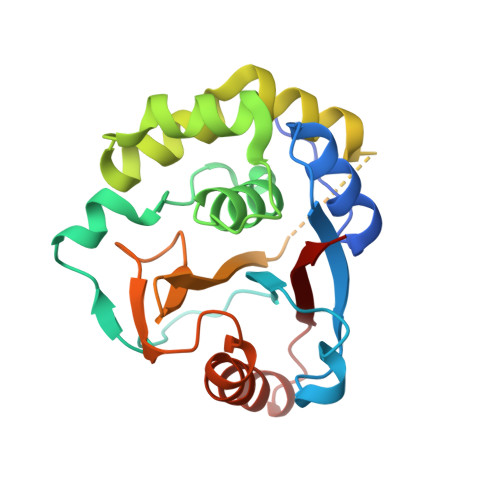Length of the active-site crossover loop defines the substrate specificity of ubiquitin C-terminal hydrolases for ubiquitin chains.
Zhou, Z.R., Zhang, Y.H., Liu, S., Song, A.X., Hu, H.Y.(2012) Biochem J 441: 143-149
- PubMed: 21851340
- DOI: https://doi.org/10.1042/BJ20110699
- Primary Citation of Related Structures:
3TB3 - PubMed Abstract:
UCHs [Ub (ubiquitin) C-terminal hydrolases] are a family of deubiquitinating enzymes that are often thought to only remove small C-terminal peptide tails from Ub adducts. Among the four UCHs identified to date, neither UCH-L3 nor UCH-L1 can catalyse the hydrolysis of isopeptide Ub chains, but UCH-L5 can when it is present in the PA700 complex of the proteasome. In the present paper, we report that the UCH domain of UCH-L5, different from UCH-L1 and UCH-L3, by itself can process the K48-diUb (Lys48-linked di-ubiquitin) substrate by cleaving the isopeptide bond between two Ub units. The catalytic specificity of the four UCHs is dependent on the length of the active-site crossover loop. The UCH domain with a long crossover loop (usually >14 residues), such as that of UCH-L5 or BAP1 [BRCA1 (breast cancer early-onset 1)-associated protein 1], is able to cleave both small and large Ub derivatives, whereas the one with a short loop can only process small Ub derivatives. We also found that elongation of the crossover loop enables UCH-L1 to have isopeptidase activity for K48-diUb in a length-dependent manner. Thus the loop length of UCHs defines their substrate specificity for diUb chains, suggesting that the chain flexibility of the crossover loop plays an important role in determining its catalytic activity and substrate specificity for cleaving isopeptide Ub chains.
Organizational Affiliation:
State Key Laboratory of Molecular Biology, Institute of Biochemistry and Cell Biology, Shanghai Institutes for Biological Sciences, Chinese Academy of Sciences, Shanghai 200031, China.















